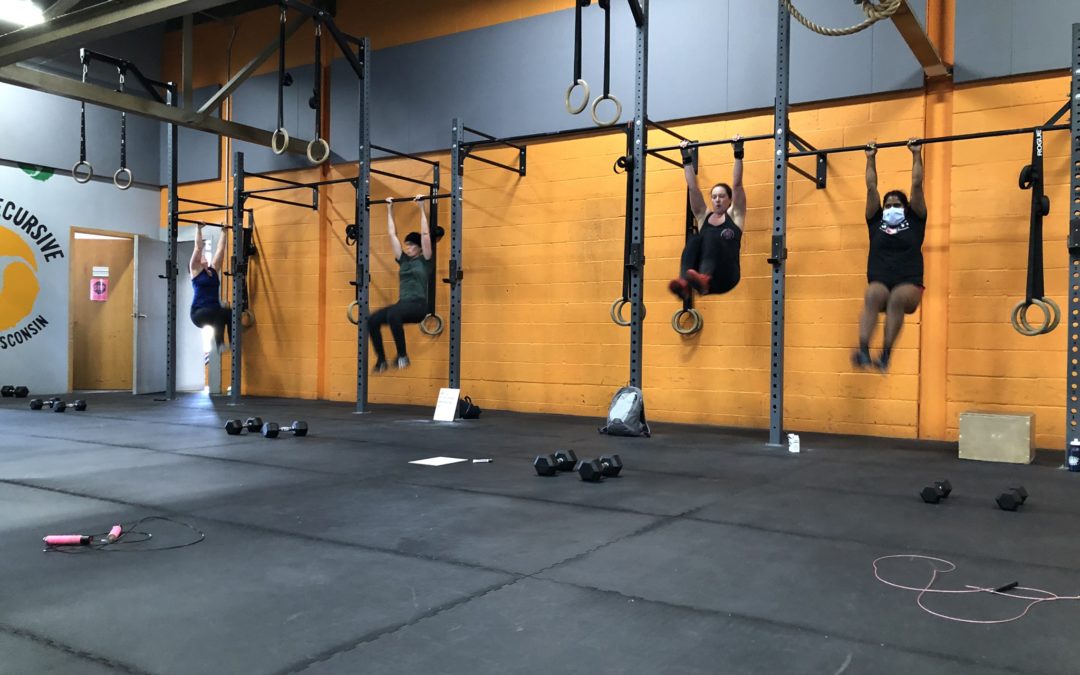Ah, those Toes to Bar. A sometimes elusive movement for even the fittest athlete. Toes to Bar don’t SEEM to be such a difficult movement, but they certainly can give even the best athletes a run for their money in the middle of a workout. Aside from getting your toes to that bar in sync, it can be a challenge to string those bad boys together. There are a few reasons you may be struggling, and some things you can work on.
Weak Lower Abdominal Muscles
This is usually the first place we look for the problem and while they can be a culprit, (especially in the untrained population), chances are this is actually only a small piece of the puzzle for most folks. If you have trouble with most (or all) abdominal/midline exercises, this is where you should first focus some attention.
Test to see if this is you by hanging from a bar and performing mini-crunches. Bring your knees to waist height without touching the floor between reps. Repeat this for AMRAP in 30 seconds. You should be able to get at least 15 reps in 30 seconds. If you cannot, you might consider putting in some extra time on your abs with any or all of these exercises to strengthen your midline.
Weak Shoulder Girdle and/or Lats
These are the other common culprits when it comes to strength deficiency for completing toes-to-bar. The shoulders aren’t just responsible for connecting our arms to our bodies, they are the first thing to activate in the toes-to-bar (and pull-up). They should continue to be active and strong throughout the entire movement – not only to protect our shoulder joints but to also provide assistance in the kipping movement on the backswing and to lessen the distance our toes have to travel to touch the bar.
That first bit of shoulder activation when we hang from the bar is called a scapular pull-up and you should be able to hold that position for 30 seconds and you should also be able to do at least 10 unbroken reps of the movement.
The backswing and the toe-distance lessening are mostly controlled by strong lat muscles which allow you to push down on the bar to create a bigger, stronger kip. The stronger this portion of the swing, the higher the body travels and the shorter the distance your toes have to travel to touch the bar.
Here’s a test you can do with a partner to determine if you need to work on strengthening your lats (or just learn how to activate them). If you find that you are strong enough to do this test then great – you just needed to remind your lats of their role in all of this. But if you’re struggling to maintain the hollow position in this test, keep doing the test everyday until it’s easy.
You should also work more pulling exercises and static holds into your routine. Ideas for pulling: pull-ups with varying hand grips, ring rows, DB rows, landmine rows, barbell rows, Crossover Symmetry, hand-over-hand sled pulls, heck, you could even try swimming!
Ideas for static holds: straight-arm hangs with scapular retraction, chin-over-bar holds, chest-to-bar holds, or get your lower abs and scaps at the same time with L-hangs.
Lack of Thoracic Mobility
This is where I believe many people’s problems lie with toes-to-bar, pull-ups and life in general. A lot of times people mistakenly think they lack shoulder mobility (which could be the case) when it is actually thoracic mobility that is the problem.
Here’s a test that is also a treatment. If you can’t pass this (wall slide) test, keep doing it until you can. The front swing (Superman or bow position) on kip requires a great deal of thoracic mobility to be able to push your head and chest through. So if you struggle with this portion of the toes-to-bar (or pull-up) then look here first.
If you can’t pass this test, you shouldn’t be going overhead movements with weight nor should you be kipping (jamming yourself) into a position you cannot safely achieve.
Just to be absolutely clear, if you can’t perform these wall slides you also cannot perform a safe overhead position or a safe kip – so don’t get too hung up performing kipping movements in workouts until you can proficiently perform your wall slide.
Tight Hamstrings
These are the final place to look, especially if you are good to go in the three areas listed above. If your kip timing is on point and you are able to get your knees to your armpits consistently, then you should be able to do toes-to-bar.
Once your knees are in your armpits, all it takes is a quick knee-extending kick to touch those toes to the bar. So if you struggle with high-kicks in the warm-up or you can’t touch your toes, lack of hamstring flexibility is likely your demise in toes-to-bar, deadlifts, the second position in Olympic lifting and tying your shoes for time.
More hamstring mashing, flossing, inch worming and high-kicking for you! Chances are, you might need a little extra help from a body worker or yoga. Don’t forget that we are always shooting for the ultimate balance in life and athletics. So if you spend five hours per week contracting your muscles by lifting weights in the gym, you should also spend five hours stretching those muscles as well. I wonder how many of our Yins and Yangs are balanced? Just something to consider…
Just like with any sport or skill we want to improve upon, we should break down the movement to address its individual parts. This will allow us to identify weak links in our bodies and technique and address each of them separately so that when we put it all back together!

